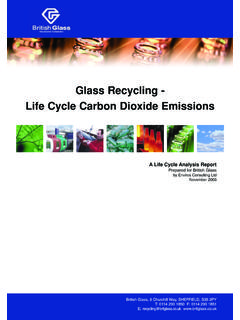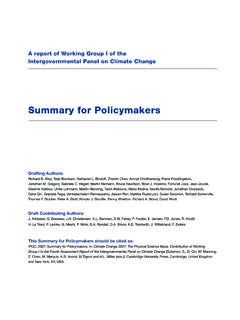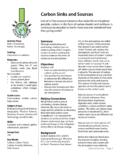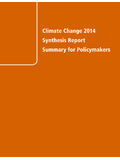Transcription of Flueless gas fires – concentration of carbon monoxide ...
1 HSE Health & Safety Executive Flueless gas fires concentration of carbon monoxide , carbon dioxide , and nitrogen dioxide , and particulate level produced in use Prepared by Advantica Technologies Limited for the Health and Safety Executive 2004 RESEARCH REPORT 23 HSE Health & Safety Executive Flueless gas fires concentration of carbon monoxide , carbon dioxide , and nitrogen dioxide , and particulate level produced in use Hill & S. MarksAdvantica Technologies Limited Ashby Road Loughborough Leicestershire LE11 3GR A series of experiments was performed to investigate the concentration of combustion products ( carbon dioxide , carbon monoxide and nitrogen dioxide ) and particulate levels produced by three models of Flueless gas heater. In all tests, the controls and thermostat were set so that the appliance operated continuously at full heat output. Items which could be altered between tests were Fuel (natural gas or propane) Ventilator position (low 100cm2, high 100cm2, or no ventilator) Room size (20m3 or 40m3) Presence or absence of the catalystThis report and the work it describes were funded by the Health and Safety Executive (HSE).
2 Its contents, including any opinions and/or conclusions expressed, are those of the authors alone and do not necessarily reflect HSE policy. HSE BOOKS Crown copyright 2003 First published 2003 ISBN 0 7176 2567 2 All rights reserved. No part of this publication may be reproduced, stored in a retrieval system, or transmitted in any form or by any means (electronic, mechanical, photocopying, recording or otherwise) without the prior written permission of the copyright owner. Applications for reproduction should be made in writing to: Licensing Division, Her Majesty's Stationery Office, St Clements House, 2-16 Colegate, Norwich NR3 1BQ or by e-mail to ii FOREWORD BY HSE/DTI The use of fixed Flueless gas fires , to supplement primary heating provided by central heating systems, has increased substantially over recent years. Such fires are not presently covered by specific product or installation standards, but are subject to certification by an independent Notified Body against compliance with the essential safety requirements of the Gas Appliances Directive (enacted by the Gas Appliances (Safety) Regulations 1995 (GASR)).
3 The Certification process includes an assessment of the manufacturer s installation instructions, and the fires are currently being installed to these instructions. Three manufacturers are currently offering a range of Flueless fires , and their installation instructions are inconsistent with one another. They specify different requirements for fixed ventilation area and minimum room size, which are also below the minimum required by BS 5440: Part 2*1. In order to encourage the manufacturers to develop common product and installation standards, HSE (with support from the Department of Trade and Industry (DTI)) agreed to sponsor the work of Advantica, reported here. The DTI have responsibility for ensuring only safe products may be placed on the market, in this instance under the GASR, while HSE has responsibility for appliance installation requirements under the Gas Safety (Installation and Use) Regulations 1998. Therefore the question of the suitability of the use of these fires is a matter of joint responsibility.
4 To this end, DTI/HSE have also been assessing information provided by the fire manufacturers, which they claim supports their view that the fires can be used without subjecting the users to harmful concentrations of combustion products. The assessment has been against a background of proposed changes to HSE occupational exposure standards for certain combustion products and an increasing awareness of indoor air quality issues. Currently, there are no UK published standards for indoor air quality, but guidelines are being considered by the Department of Health (DoH) and its advisory committees. In the absence of published information, advice was requested from the DoH Advisory Committee on Medical Effects of Air Pollutants (COMEAP), as to acceptable indoor air levels for pollutants emitted from these fires . The Advisory Committee have recommended comparing the level of pollutants with guidelines and standards published by the World Health Organisation (WHO)*2 and the Expert Panel on Air Quality Standards (EPAQS)*3, 4.
5 DTI/HSE will also need to consider any implications for other types of Flueless gas appliances, and to this end have commissioned further trials by the Building Research Establishment (BRE)*5. It should be noted that the manufacturers of these gas fires dispute any suggestion that the correct use of their fires will lead to a possible health risk. They contend that the Advantica tests represent a worst case scenario, which would seldom, if ever, be encountered in practice, and point to a limited survey (reproduced as Annex 1 of this report) carried out by Advantica in 10 homes where their fires are installed. However, the test regime (which included reduced ventilation and appliance fault mode conditions) was specifically designed to provide sufficient information to subsequently enable the likely concentrations of combustion products to be predicted for a wide range of ventilation provision, room size and potential use of the gas fires . Such predictions can iii only be based on work where all the parameters can be controlled, in a test house of the type used in the primary work of this report.
6 While acknowledging the test limitations, DTI/HSE are publishing this report in the public interest, as a contribution to the wider debate on product and installation standards for Flueless gas appliances. As part of this debate DTI/HSE are working closely with relevant bodies, the British Standards Institution (BSI), to ensure that the implications of this work are explored in developing future standards and guidelines for Flueless gas appliances. *1 BS 5440-2: 2000, Installation and maintenance of flues and ventilation for gas appliances of rated input not exceeding 70kW net (1st, 2nd and 3rd family gases) Part 2: Specification for installation and maintenance of ventilation for gas appliances, BSI, 2000 *2 World Health Organisation. Air Quality Guidelines for Europe. Second Edition. WHO Regional Publication, European Series, No 91. Copenhagen: WHO Regional Office for Europe, 2000. *3 Department of the Environment. Expert Panel on Air Quality Standards. carbon monoxide .
7 London: HMSO, 1994. *4 Department of the Environment. Expert Panel on Air Quality Standards. Nitrogen dioxide . London: HMSO, 1996. *5 Upton S, Ross D and Pierce B, Measurement and modeling of combustion products from Flueless gas appliances, HSE RR 127/2004 iv CONTENTS 1 INTRODUCTION AND BACKGROUND 1 General 1 Particulate Matter 1 2 EXPERIMENTAL EQUIPMENT AND PROCEDURE 3 Test Enclosure 3 Heating appliances 5 Experimental Measurement and Monitoring 9 3 EXPERIMENTAL PROGRAMME 11 4 RESULTS 13 Effect of vent position 14 Effect of room size 15 Effect of catalyst 15 Stratification
8 21 Cycling 21 Relative Humidity Measurements 23 Particulate Data 27 5 DISCUSSION 29 6 RECOMMENDATIONS 31 Appendix 1 Indoor air quality in ten homes with Flueless heaters in the Leicestershire area 32 v vi SUMMARY The last few years has seen the launch of a new generation of Flueless gas fires and stoves incorporating new technology safety devices, such as oxygen depletion-sensing pilots, and catalysts to reduce the harmful flue products.
9 The main objective of this of work was to carry out an investigation into the safe operation of fixed gas-fired Flueless space heaters with respect to the levels of combustion product emissions within the home. It provides information on the long-term safety issues relating to the exposure to emissions from this type of Flueless heater and amongst other criteria, it examines the effects of installation practices where the sizes of rooms and ventilation openings are below those given as minimum requirements by the manufacturer, as well as looking at the implications of the failure of the appliance catalyst that converts the carbon monoxide produced during the combustion process into carbon dioxide . The experimental programme consisted of 28 tests. In the main test programme, the operating conditions of three appliances manufactured in the United Kingdom were varied. The items which could be varied were Fuel (natural gas or propane) Ventilator position (low 100cm2, high 100cm2, or no ventilator) Room size (20m3 or 40m3) Presence or absence of the catalyst In all tests, the controls and thermostat were set so that the appliance operated continuously at full heat output.
10 In addition, the results from one test during which the appliance was allowed to cycle on and off, with the thermostat operating normally, are included. Four tests were also performed in the 20m3 room, with no ventilator, to measure the concentrations of carbon monoxide , carbon dioxide and oxygen in the firebox before the catalyst, and in the flue after the catalyst. The recommendations are: The carbon dioxide concentrations , after two hours continuous operation, were in all cases, greater than the 8 hour limits in EH401. It should be noted that these appliances are not intended to be the sole heat source in a room and in normal operation the appliance will be cycled on and off by the thermostat to maintain a constant room temperature. The concentration of carbon dioxide in real-life environments in an occupied house under normal conditions, containing these appliances, should be monitored to see if the concentration of carbon dioxide does present a potential problem.


















